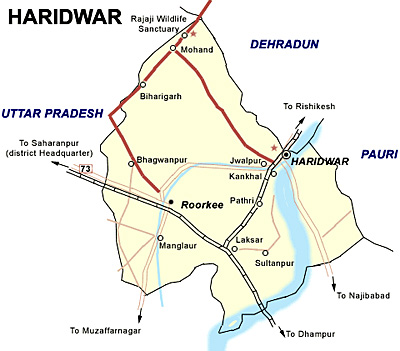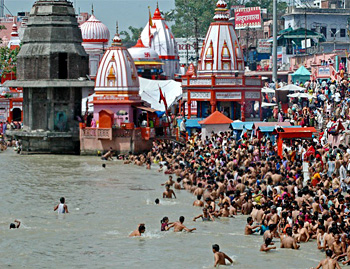 Haridwar District is located in the western part of Uttarakhand. The district headquarter is situated at Haridwar. Haridwar District is covering a total area of about 2360 sq kms. Haridwar is considered as a paradise for nature lovers. It presents a kaleidoscope of Indian culture and civilization. Haridwar also termed as `Gateway to Gods` is known as Mayapuri, Kapila, Gangadwar as well. It is also a point of entry to Dev Bhoomi and Char Dham (Four main centres of pilgrimage in Uttarakhand) namely Badrinath, Kedarnath, Gangotri and Yamunotri.
Haridwar District is located in the western part of Uttarakhand. The district headquarter is situated at Haridwar. Haridwar District is covering a total area of about 2360 sq kms. Haridwar is considered as a paradise for nature lovers. It presents a kaleidoscope of Indian culture and civilization. Haridwar also termed as `Gateway to Gods` is known as Mayapuri, Kapila, Gangadwar as well. It is also a point of entry to Dev Bhoomi and Char Dham (Four main centres of pilgrimage in Uttarakhand) namely Badrinath, Kedarnath, Gangotri and Yamunotri.
Location of Haridwar District
Haridwar District is located between 29 degree 58 minutes north latitude and 78 degree 13 minutes east longitude respectively. Average elevation of the district from the sea level is around 249.7 metres. Haridwar District is bounded by Saharanpur in the west, Dehradun in the north and east, Pauri Garhwal in the east, Muzaffarnagar and Bijnor in the south. Due to Haridwar`s location on the bank of Ganga River, it has plenty of water resources and almost all kind of food grains are produced here in abundance.
History of Haridwar District
Archaeological findings have proved that terracotta culture dating between 1700 B.C. and 1200 B.C. existed in this region. Haridwar District came into existence on 28th of December, 1988. Prior to its inclusion in the newly created state of Uttarakhand, this district was a part of Saharanpur Divisional Commissionery. Being one of the oldest living cities, Haridwar finds its mention in the ancient Hindu scriptures as it waves through the life and time stretching from the period of Lord Buddha to the more recent British advent. Haridwar`s long standing position as a great source for Ayurvedic medicines and herbal remedies as well as its unique Gurukul school of traditional education, the scenic beauty and lush greenery all give the city unique flavors and charm.
Administration of Haridwar District
 Haridwar District is administratively subdivided into three tehsils namely Haridwar, Roorkee and Laksar. There are six development blocks and these are Bhagwanpur, Roorkee, Narsan, Bahadrabad, Laksar and Khanpur. As per the 2001 census, the population of the district is 14,44,213. The district is headed by District Magistrate or Deputy Commissioner. The subdivisions are headed by Sub Divisional Officer. Each subdivision serves the purpose of general, criminal and revenue administration of the district. For development works, a chief development officer (CDO) is posted at district head quarter who heads a team of Block Development Officers at blocks.
Haridwar District is administratively subdivided into three tehsils namely Haridwar, Roorkee and Laksar. There are six development blocks and these are Bhagwanpur, Roorkee, Narsan, Bahadrabad, Laksar and Khanpur. As per the 2001 census, the population of the district is 14,44,213. The district is headed by District Magistrate or Deputy Commissioner. The subdivisions are headed by Sub Divisional Officer. Each subdivision serves the purpose of general, criminal and revenue administration of the district. For development works, a chief development officer (CDO) is posted at district head quarter who heads a team of Block Development Officers at blocks.
Culture of Haridwar District
Culture of Haridwar District is rich and vibrant. Haridwar is also one of the four places; where Kumbha Mela is organized after rotation of every twelve years and Ardh Kumbha after every six years. Haridwar is one place where fairs are being organized with full enthusiasm throughout the year, such as Somwati Amavasya, Kartik Purnima, Shravan Purnima, Ganga Dussehra and more. The Kanwad mela during the month of Shravana is very popular among masses in which thousands of devotees of Lord Shiva come to Haridwar. District administration also organises `Haridwar Mahotsava`, a cultural festival on the bank of river Ganga and `Ayurveda Mahotsava`.
Tourism in Haridwar District
Haridwar is one of the first towns where Ganga River emerges from the mountains to touch the planes. And that is why the water is crystal clear and cool. Lush green forests and small ponds add to the scenic beauty of this holy land. The Rajaji National Park is just 10 kms from Haridwar. It is an ideal destination for wild life and adventure lovers. In the evening the ghats look breathtakingly beautiful as thousands of diyas (lamps) and marigold flowers float and illuminate the holy waters.
BHEL, producer of heavy industrial goods, is also located at Haridwar. The Roorkee University at Roorkee is one of the oldest and most prestigious institutes of learning in the fields of science and engineering.



















